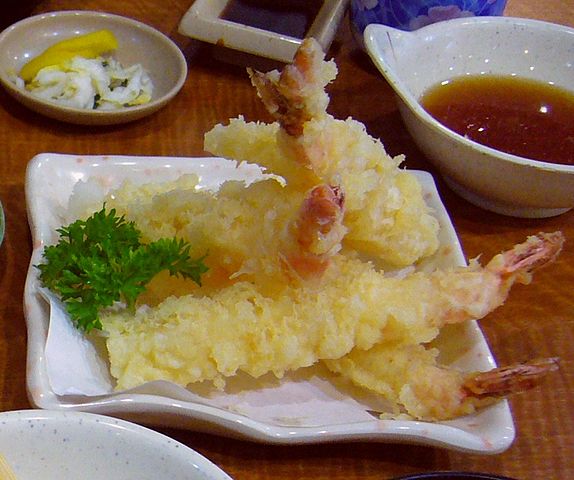| Actualite |
Tempura
par Raphael
Tempura is one of the Japanese foods that has become known around the world. The delicious combination of fresh seafood or vegetables with crisp, hot batter has pleased the palates of diners everywhere. Although tempura is a centuries-old cuisine, like many Japanese foods, it resulted from a process of importing, hybridization, and perfection. Enjoyed alone, or with rice or noodles, tempura invites diners to revel in seasonal flavors.

When tempura is made, the ingredients are first prepared. Fish are cleaned and gutted, entirely deboned, and even have their tails cut evenly to give them a uniform appearance on the plate. Vegetables are peeled, and the most delicious portions are used. The batter is made of a mixture of flour, eggs and water, gently folded together. The batter must not be mixed too much, lest it become sticky and unappetizing. Foods that have been dipped in batter must be fried immediately for the best flavor.
The most important thing for tempura is the oil temperature. The fragrant, crisp-frying sesame oil should be kept at a temperature of between 160 and 180 degrees Celsius, but the exact temperature is different for every food. A good tempura chef must know the ideal temperature for each item. With each piece of food added, the oil can drop three or four degrees in temperature, so the chef must constantly adjust the heat. When cooked properly, tempura batter seals the food it coats and thereby steams the inner contents, producing the tasty contrast of a crisp outside and a soft, moist inside. Chefs know when tempura is done by feeling the weight of the food. As tempura cooks, it actually becomes lighter, since the moisture inside evaporates. Tempura is best served fresh from the oil.
As with much Japanese food, seasonal ingredients are very important to tempura. Fish are chosen for the season they are suited to best. Prawns, known for their sweetness, are also a popular tempura food, as is squid. For the most part, light-tasting fish like whiting are thought to go best with tempura. Vegetables are also chosen for seasonal appropriateness. Many vegetables are delicious in tempura, as even bitter vegetables become mild when fried as tempura. The colorful interiors seen through the translucent batter are a natural appetite stimulant.
Tempura is only minimally seasoned so that the natural flavor of each food can shine through. There are two main types of tempura seasoning. One is a sauce made of sweet rice wine, soy sauce and salt added to a stock made from dried bonito or kelp. Many people like to add grated daikon to the sauce to balance the sweetness of the sauce and the oil in the tempura. A piece of tempura is briefly dipped in the sauce, then eaten. Salt can also be used alone as a seasoning, particularly when the diner wants to focus on the natural taste of the ingredients.
There are a number of dishes made by combining tempura with other foods, as well. Tempura can be combined with rice, as in the popular dish known as “tendon,” which is tempura dipped in sweet sauce and served over rice. Tempura is also enjoyed with soba noodles in a soy-based soup that is perfect for the colder months. Meat, however, is almost never included in tempura. According to tempura chefs, foods that are naturally high in fats, like meat, don’t taste good when cooked in the tempura style.
Fried food in Japan dates back about a thousand years, to when a fried confection known as “togashi” was introduced to Japan from China. In the 13th century, with the rise of Buddhism, meat became taboo and vegetarian cuisines such as the food eaten by priests (known as “shoujin ryouri”) grew in popularity. Oil was used to prevent boredom with the vegetable-based diet, and frying food was known to add volume and a meat-like texture to tofu and vegetables. In the 16th century, increased trade with the West, namely Spain and Portugal, brought the idea of batter to Japan. The European fried food used a flour-based batter which Japanese cooks adapted into what we know as tempura today. A mild, unseasoned batter was thought by Japanese chefs and gourmands to enhance the foods’ natural flavors. By the 18th century, tempura was a huge hit, enjoyed particularly on the busy streets of Edo (now Tokyo), where food culture was flourishing due to a long period of peace. In the 20th century, advanced techniques for the refining of oil brought tempura to the homes of ordinary people, and tempura became even more well-known.
Film star Charlie Chaplin was particularly fond of tempura, especially prawn tempura, and declared it to be a world-class food. Although tempura was originally introduced and developed through the cuisine of foreign nations, Japan has thoroughly naturalized the technique, and perfected it to the point that tempura has become famous all over the world, and is thought of as classic Japanese cuisine.
Although many restaurants still cook the same sort of tempura that has been sold in Japan for centuries, there are of course many innovators as well, who experiment constantly with new kinds of tempura. Some new tempura dishes include clam-stuffed eggplant, and even tempura ice cream. These new recipes have attained popularity, but the classic dishes continue to be the most widespread and popular ones in Japan.
There are also innovations concerning what to do with leftover tempura oil. In contemporary, eco-conscious Japan, used oil is no longer being discarded, but is being put to good use. One program teaches children to make candles with waste oil, but even more impressively, used tempura oil has been converted into bio-diesel fuel that has been used to power a city’s night illumination and to run motor vehicles as well. Despite the food’s long history, tempura continues to change and grow, to the culinary delight of diners the world over.
Photo credits:
| Aucun commentaire |


















